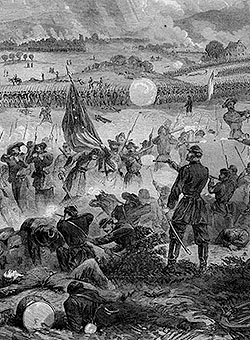
Please send all Checks and Money orders to :
Dave Taylor P.O. Box 87 Sylvania, OH 43560
419-842-1863
Click Here to E-mail Us!
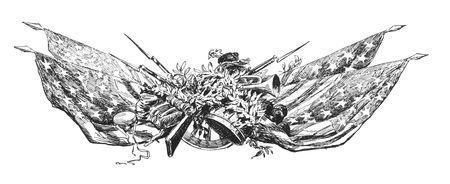
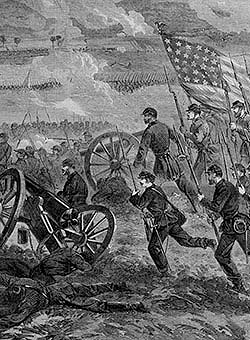
14 07
~~~~~~~~~~~
LAYAWAYS ARE WELCOME:
Need to split your order into multiple payments? No problem! A simple 20% earnest money deposit will hold your item for you.
You can then pay it off in easy installments that fit your budget.
~~~~~~~~~~

14-07-01 … Kentucky Style Fowler / Fusil w/ Relief Carving:
A very good looking and highly interesting flintlock fowler dating to the late 18th early 19th century that falls under the “Kentucky Fowler” heading. Octagon to round barrel measures 33 inches with a sight groove at the rear, about .60 Caliber. 49 inches overall gun length. Nice untouched patina running deep brown. Full stock just shy of the muzzle, two ramrod pipes and an entry pipe. Excellent wood with nice middling brown patina and only minor scattered small dots from 200 years of handling. Lock is unmarked and darkly patinated matching the barrel, with only some mild brown crust. Some corrosion in flash pan from use, as is to be expected. The brass mounts have a nice undisturbed age patina: ramrod pipes, side plate, butt plate, and trigger guard with grip rail and incised lines. The gun was designed to shoot birds on the wing, using a shorter fowler barrel for better handling and a roller bearing on the frizzen spring to quicken ignition. Though sharing some elements with British and German fowler design, the gun has several characteristics that link it to Pennsylvania/Kentucky rifle design: The use of a grip rail with the trigger guard, the presence of a cheek piece and flat bottom on the underside of the butt stock, and the use of a squared-off butt plate tang. Further, not only does the side plate look very Kentucky-ish, there is a wonderful raised-carved flower stem that curves along under the cheek piece and blossoms in the space between that and the butt plate. This is a fowler that saw some use and was obviously made for someone who appreciated a nice gun. The full stock gives it a slightly military flavor. My feeling is that it is a pre War of 1812 weapon and likely American made. No proof marks present is also a strong indication that this gun was made in the US. The Brits seemed to have always proofed their barrels
… $1,795.00 SOLD
Click Here to E-mail Us!
Call us @ 419-842-1863
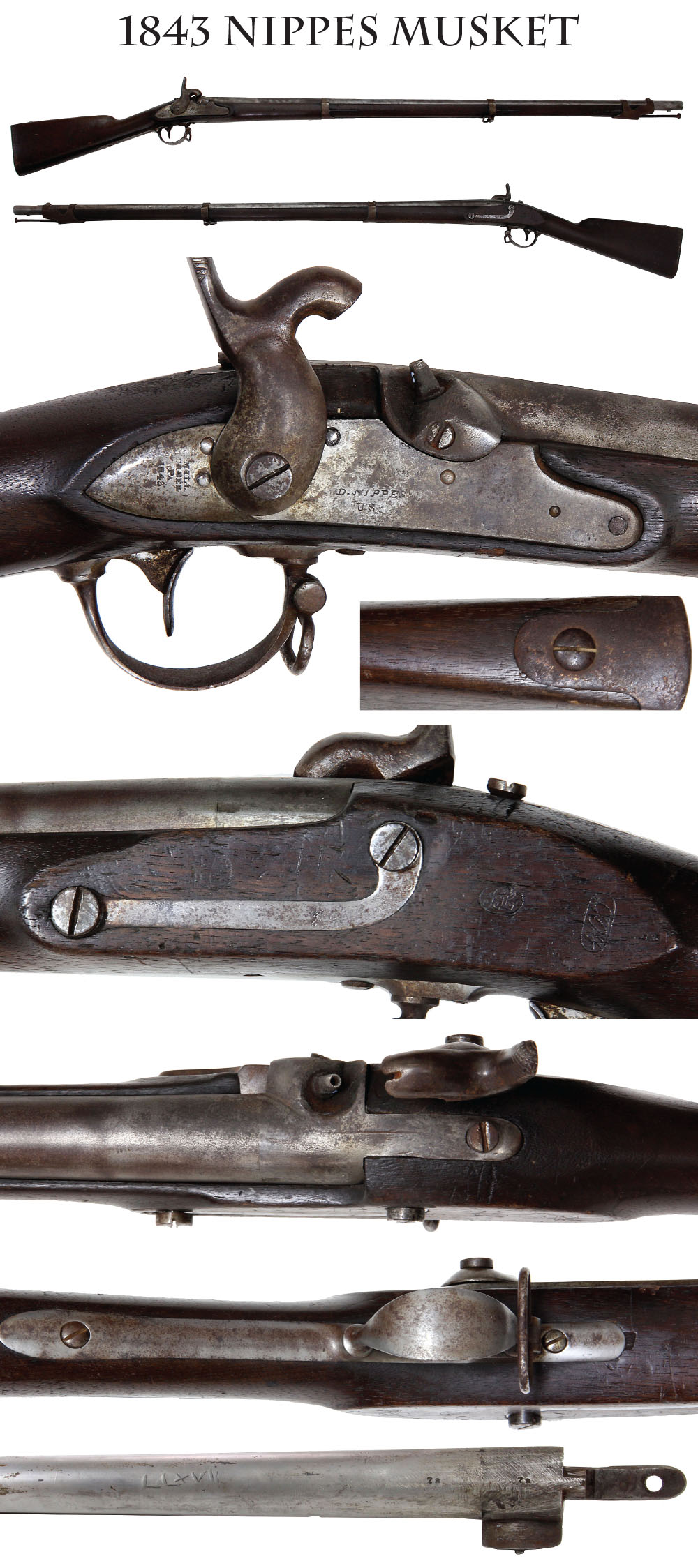
14-07-02 … 14-01-45 … Scarce US Model 1835/40 Conversion Musket. “D. Nippes/ US” 1843.
Nippes made 5600 contract muskets in the 1835/40 pattern, most of which were converted to percussion. This is one of those guns. Overall condition very good to attic fine. Has two clear cartouches on the stock opposite the lock. Wood is extra fine. A tight sharp musket and one of the scarcer patterns. 100% original and complete, except for replaced rod done during the period. Mechanically perfect. A scarce gun at a fair price
… $995.00
Click Here to E-mail Us!
Call us @ 419-842-1863

14-07-03 … Spectacular Cadet Model 1844 Piedmontese Musket with Bayonet:
An exact miniature of the full size musket still in .69 caliber. Barrel is 30 inches. Overall length is 43 inches. Perfect size for an eight or ten year old boy. It is based on the French 1822 musket and adopted in the Italian Kingdom of Piedmont in 1844 (also called Piedmont-Sardinia as the Kingdom of Sardinia absorbed and unified the various smaller Italian states.) The full size weapons were produced at the state arsenal at Torino and on contract in Belgium. A number of the Belgian produced guns made their way over here as part of the early war effort to supplement our own arms production. Ours is a cadet version made at Torino and dated 1864 on the lock and 1865 on the right breech. Clear lock plate markings, numerous assembly numbers on the various parts and proofs on the barrel. Iron mounted overall. All bands, springs and swivels in place. Ramrod an old replacement. Metal is attractive light brown patina with some darker spots, smooth overall. Wood is very pleasing with a couple of dings and some dark areas along the butt plate. The circular government ink stamp is still visible on the offside of the butt stock. Also included is its original bayonet, which is tough to find, missing its locking ring, but matching the metal of the gun in color. I have always been fascinated by boys muskets, cadet muskets, etc… Likely a throwback to what I would have wanted in my childhood. I never pass up the opportunity to buy one of these Lilliputian rarities when I find one priced honestly. Here is a superb example. Totally charming. Incredibly rare yet affordable
… $895.00 SOLD
Click Here to E-mail Us!
Call us @ 419-842-1863

14-07-04 … Springfield 1863 Rifle Musket Type I :
These 1863 pattern Springfields modified the 1861 pattern in a number of ways. The most obvious is the use of a beveled hammer (thank you Samuel Colt) and the elimination of retaining band springs by using rounded contour screw-fastened clamping bands. This last innovation quickly proved to be a problem when recoil energy in firing jolted the bands loose. In short order the Type II (a.k.a.1864) pattern M1863 reintroduced the retaining springs which were kept on Springfields up through the M-1 Garand of WW2 and Korea. Bright steel overall, with some original bright finish and some cleaned areas. Clear lockplate marking of 1864 rear of the hammer and U.S. over Springfield forward of the hammer with just some scattered graying on the hammer from the casehardening. The Springfield eagle with shield appears on the bolster and just to the right of hammer, being a little soft in areas. Very nice wood, with a set of lightly carved initials on the offside of the butt, still showing very evident ink inspector cartouches on the wood opposite the lock. The wood still has strong and just slight rounding from handling on the forward edge. Good wood-to-metal fit overall. Sharp US on buttplate tang, directional “U”s on bands, swivels and correct rod in place. Correct mid war rear sight and leaves; front sight firmly in place. Clear V/P/eagle barrel proofs at left breach. Barrel date is clear, a bit light on the last digit which is a “3” showing the barrel was made in late 1863 and assembled with a lock made in early 1864- all completely correct. The breechplug tang shows a little bit of buggering along the edges and there is a very light vise clamp mark just under the rear sight on the offside, but this is not very noticeable. A nice example of the classic Civil War infantry arm and one looking a lot like it did when it came out of the crate
… $1,950.00
Click Here to E-mail Us!
Call us @ 419-842-1863
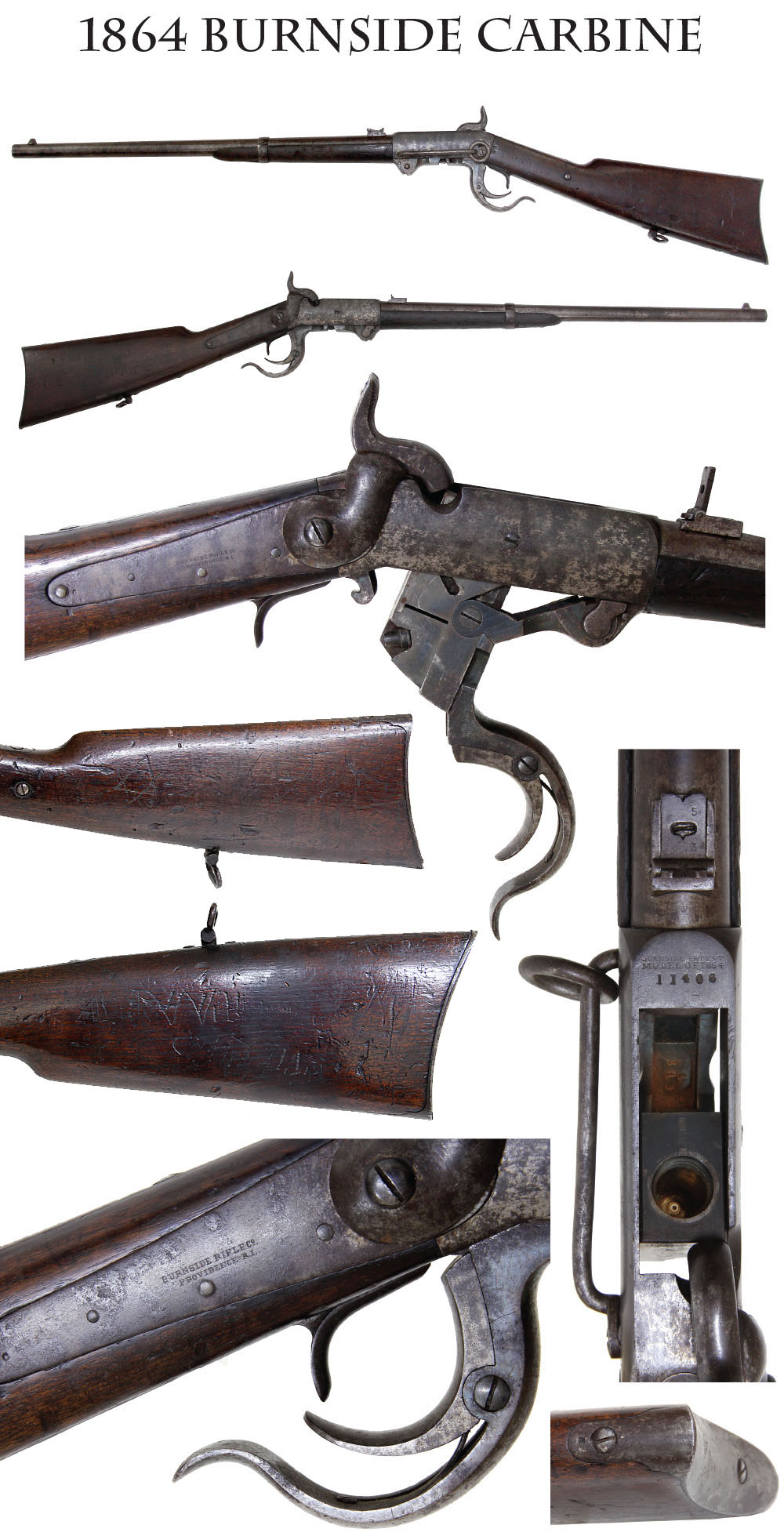
14-07-05 … Field Used and Soldier Carved 5th Model Burnside with likely Texas or Illinois Association:
The Fifth Model Burnside is the most commonly encountered type of Burnside purchased by the government and issued during the war. The key distinguishing feature is the guide screw in the center of the right side of the frame to make the breechblock operate more smoothly. This is a late production piece marked “Burnside’s Patent/ Model of 1864”. This pattern was produced starting in 1863 and numbered about 43,000 by war’s end. Ours is a real issued and field-used example. The metal shows gray for the most part, with mottling on the case-hardened receiver and more vivid case on the breechblock when lowered. Sling swivels and sling bar and ring are in place, as are the front sight and rear sight with leaves. Traces of blue survive in protected areas. This carbine is serial numbered 11406, which is bracketed by many guns recorded in May, 1865, in the hands of Co. C, 2nd Texas Cavalry (U.S.): including numbers 11404 and 11412. A miss is often as good as a mile with serial number ranges of course, but it is a place to start. There is also another interesting piece of evidence: 11426 was recorded, also in 1865, in the hands of Co. D 6th Illinois Cavalry. There is some soldier carving on the buttstock that might ultimately provide an identification. One side is an eight pointed star- a Star of David, an Eighth Corps badge, or just a decorative device. On the other side is carved a name … “A.J.” followed by a last name beginning “Will..” … either Williams or Williamson. Underneath is clearly carved “Co.” and the letter “H” and then a designation that is hard to decipher. Researching the 6th Illinois Cavalry one candidate could be Andrew Williamson, Co. H, 6th Illinois Cavalry, who signed up late in the war as a recruit on 2/14/65 and served until discharged at Selma, Alabama, 11/5/65. He died in Mount Vernon, Illinois, in 1926. I cannot find a roster of the 4th Texas Cavalry to research soldiers with names of Williams or Williamson … will leave that to you. The STAR carving might be an indication of association with Texas???? Or it might be a random decoration. This is all speculation, of course (didn’t I qualify it enough?), but chasing down the history is more than half the fun on historical relics with evidence of ownership. No matter what, this is nice example of real trooper carried weapon, showing much use, but not abuse, and would be a great addition to a cavalry collection. I am confident the gun served in Texas or Illinois and it is a fairly priced antique gun in any event
… $1,495.00 SOLD
Click Here to E-mail Us!
Call us @ 419-842-1863
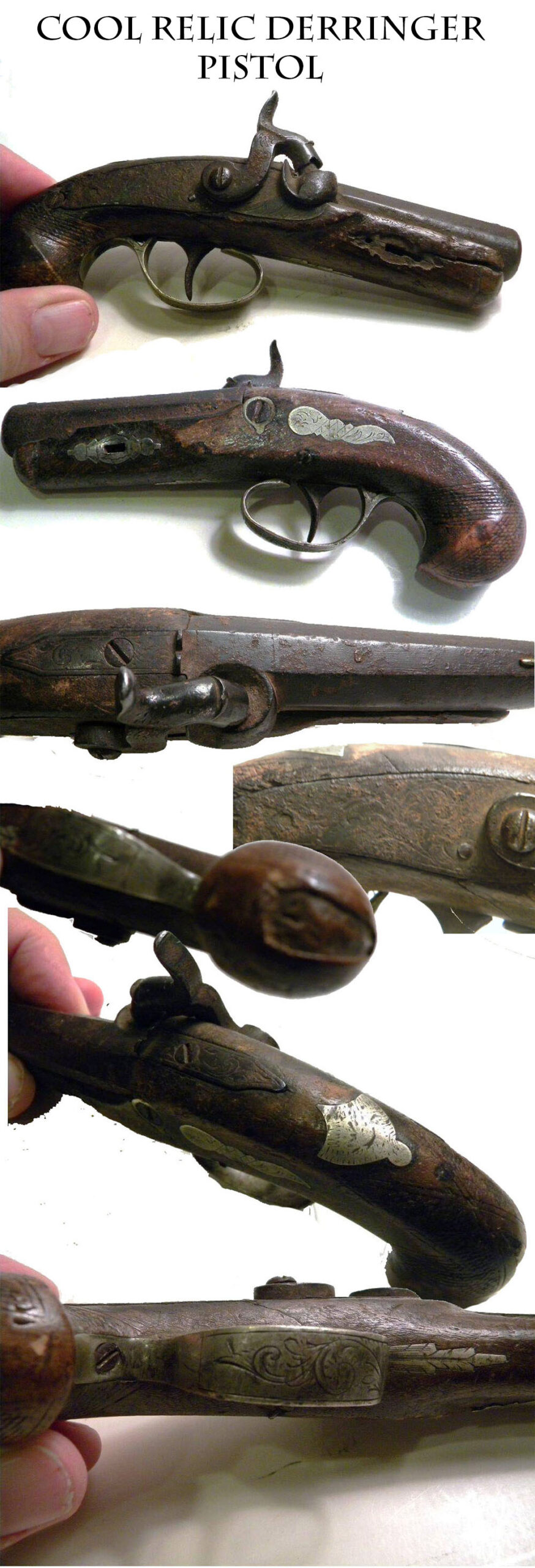
14-07-06 … Relic Philadelphia Style Derringer:
Absolutely 100% honest and untouched for decades. Looks like an old barn find. Classic Philadelphia style patterned after the famed Henry Deringer pistols (one “r”). This one unsigned. Overall fair condition. Rusty, crusty, and dry. Some wood damage on the right side from the missing key escutcheon forward. Finely engraved trigger guard and wrist escutcheon. Left side escutcheon present. Missing the escutcheon plate on the butt. Lock shows fine engraving. Will go to half cock but not full. This looks like the guns in the old GAR museums that were picked up on battlefields in the years immediately following the Civil War. 3 1/8 inch barrel. Roughly 41 caliber
… $395.00 SOLD
Click Here to E-mail Us!
Call us @ 419-842-1863

14-07-07 … SPUR …
One regulation CW cavalry spur… There’s only one, so it jingles, but doesn’t jangle
… $75.00 SOLD
Click Here to E-mail Us!
Call us @ 419-842-1863

14-07-08 … P-53 Enfield Rifle Musket Dated 1862:
The 1853 Enfield Rifle musket was imported in huge quantities by both North and South. Ours is in untouched attic condition and dated 1862. Lockplate marked with British crown at rear and 1862 over Tower at front. Hammer and bolster both show brown with light pitting overall from wartime use in the field. Lock plate generally cleaner with some dark gray toward the front. Has correct three steel bands, and brass trigger guard and butt plate. Correct knurled-head ramrod showing matching light pitting. Both sights in place, as are swivels. Barrel dark brown overall, with clear *25*25 stamps indicating .577 caliber, and 25 bullets to the pound. Wood has good edges, generally toward the dark, but with a lengthwise tiger striping of light and dark on the butt stock. The usual minor dings. One small notch on the forward end of the raised lock table. Nice nipple, not battered down, some small letters stamped in the wood. This is a nice veteran of the war, likely brought home and propped in a corner for a century and a half
… $1,450.00
Click Here to E-mail Us!
Call us @ 419-842-1863
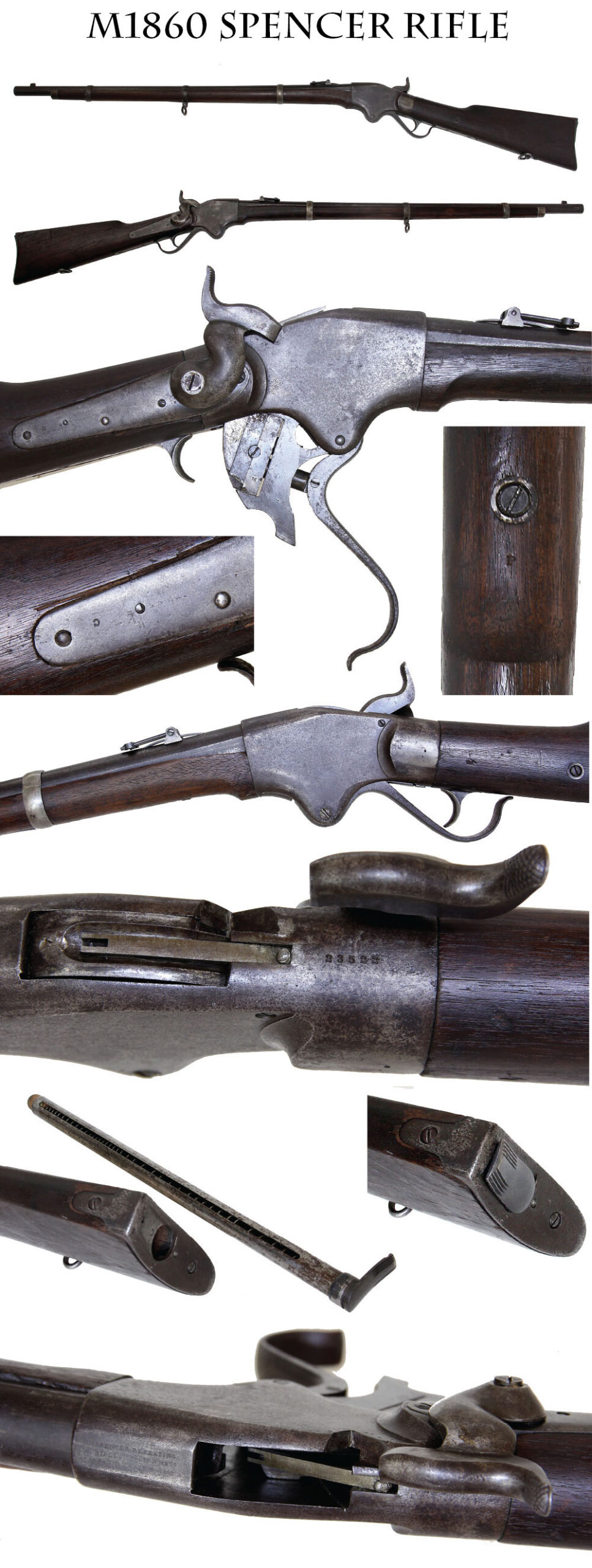
14-07-09 … 1860 Pattern Spencer Repeating Rifle:
The Spencer needs little introduction to Civil War collectors. .52 caliber, seven-shot rimfire, introduced in 1862, the rifles first went to the Navy and then to the army, being supplied to such notable organizations as Custer’s Michigan Cavalry Brigade and Wilder’s Lightning Brigade. The carbines weren’t delivered until late summer 1863 so prior to that time we see the 3-band rifle in the hands of infantrymen, mounted infantrymen, and Custer’s cavalry troopers. This is the standard Civil War 1860 pattern rifle, serial numbered 23522. 100% original, 100% complete, and mechanically perfect. Smooth metal to the barrel with a purplish gray to plum brown cast from the oxidation of the original bluing. Nose cap and barrel bands somewhat brighter. Receiver and hammer retain hints of faded case colors in purplish clouds on silver-gray. Brighter case visible on the lever and block when lowered. Very minor pinprick salt-and-peppering on the receiver and slight corrosion around the serial number. Tight wood to metal fit overall, just a hair’s breadth of shrinkage on the top edge of the lockplate tang and slight chip off left side of forestock at base next to receiver, which is common. Clear Spencer patent date and information on the forward part of the receiver. Both sights in place, including spring and leaf on rear sight. Both swivels in place. Magazine tube present and withdraws fine. Hammer screw replaced. Very minor dings to wood here and there. A good example of a formidable weapon on the battlefield. These Spencers and the famed Henry Rifles were the most famous and widely used repeating rifles of the Civil War. They were produced in nearly equal quantities but the Henry commands prices in VG condition of $25,000.00 and in fine condition $75,000. This is solely due to the fact that the Henry is a key arm in any Winchester collection… being the forerunner. These Spencers packed more of a wallop than the puny .44 caliber Henrys… and the Spencers saw more hard combat use than the Henrys ever did. Best of all these Spencers cost but a fraction the price of a Henry Rifle. A darn nice example
… $3,250.00 SOLD
Click Here to E-mail Us!
Call us @ 419-842-1863
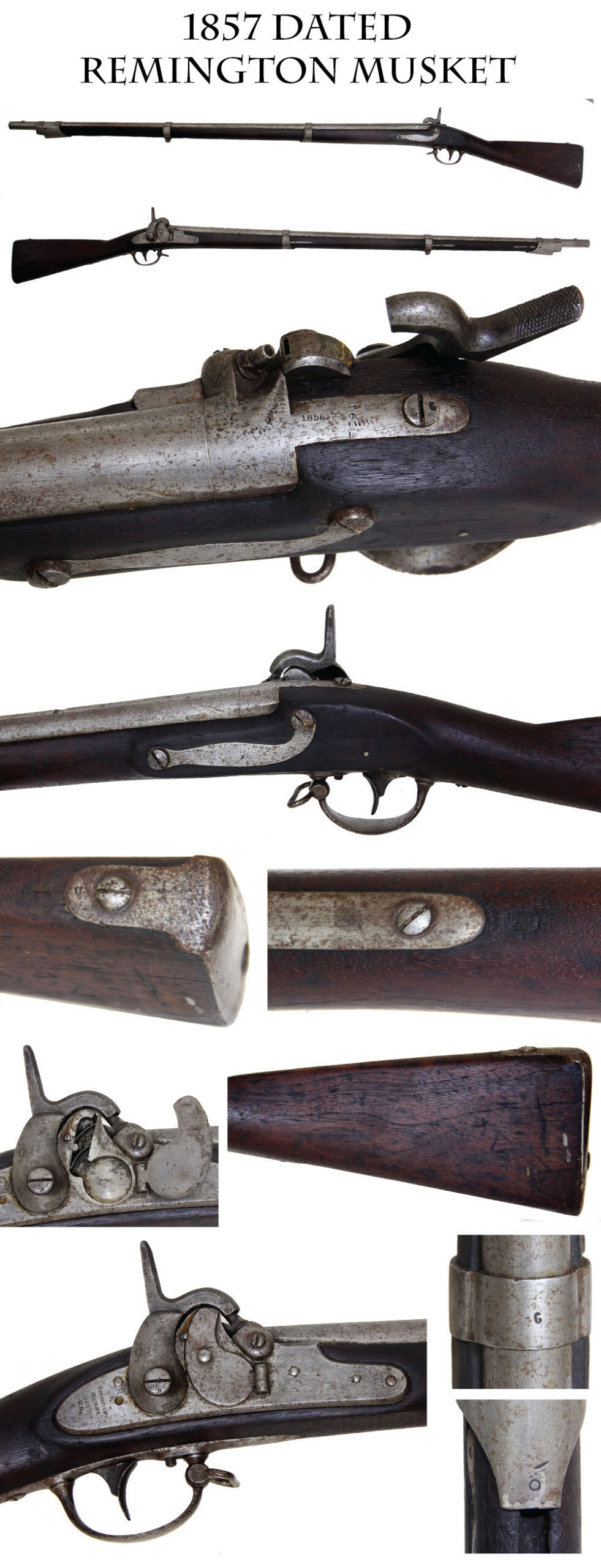
14-07-10 … Frankford Arsenal 1857 Remington Maynard Conversion Musket:
The military experimented with a number of systems to try to improve on the percussion cap, which had to be carried separately from the weapon and the cartridges. Dr. Maynard’s tape primer system eventually found favor and the Remington Arms Co. received a contract from the government to supply 20,000 primer locks and bolsters to the Frankford Arsenal where they would be fitted to converted 1816 pattern muskets which would be rifled and sighted in an attempt to bring them up to par with the new 1855 series of arms. This example has very sharp lock and breech markings: “Remington’s/ Ilion N.Y./1857/U.S.” on the rear of the lockplate and “1856” on the breechplug tang with a small “JT” inspector stamp, indicating assembly early in 1857, the period of conversions at the arsenal running from 1856 to 1859. Some of these guns went to the Navy, others went to regular army units on the western frontier such as the 6th US Infantry in Kansas in 1857. New York also received a large number of them for its troops. Ours has a “K” over “91” stamped on the breechplug tang, possibly indicating the 91st NY, but more likely a soldier with a rack number of 91 in Company K. The metal is smooth, bright silver/gray with some scattered small brown spots overall. Small S-shaped scratch in the metal on left breech just forward of the conversion breech line. Screw slots good. Nipple is good, not battered, primer mechanism works and door pivots easily. Wood is generally a dark, rich brown, slight rounding to contours from use and handling, moderate chipping along the ramrod channel and minor dings overall., … looks like an old small “x” scratched near the buttplate and maybe a “v.” No ramrod, rear sight and upper swivel missing, otherwise complete. These could be replaced without too much effort. ;Mechanically excellent. A nice pre-war and early Civil War rifled musket typical of those carried in the opening battles of the Civil War and for several years after. Priced as friendly as I can make it
… $895.00 SOLD
Click Here to E-mail Us!
Call us @ 419-842-1863
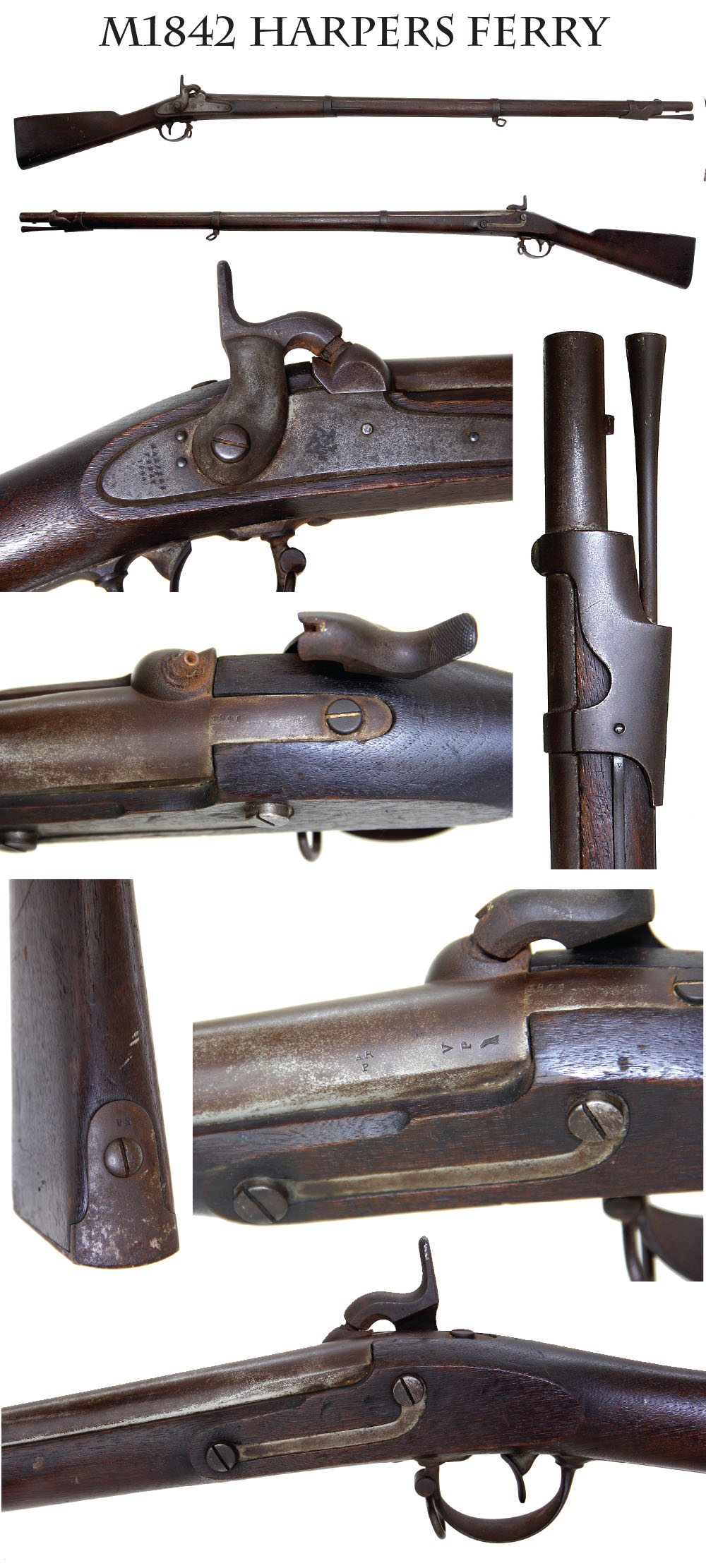
14-07-11 … Mexican War Dated Harper’s Ferry 1842 Musket:
Harper’s Ferry made 1842s have always been a prize. Finding one like this with a real Mexican War date and in VG or better condition is a rarity! The last of the old line .69 Caliber infantry smoothbore muskets and the first of the new percussion series of arms, the 1842 is a keystone in any collection of US military long arms, and this one has condition! This gun has extremely sharp edges on the wood around the lock and along the barrel channel. The metal is smooth, a silvery gray showing through plum brown surface patina. The lock plate is slightly dark but shows a clear Harpers Ferry over 1844 at the rear and a Harpers Ferry eagle over US in front of the hammer. The barrel date is an equally clear 1845, showing the gun was assembled early that year. Very clear V/P/eagle proof and small letter AR over P just forward. Bayonet lug, swivels, bands, springs, and correct rod all in place. Mechanically good. Some light surface rust around the nipple that could be cleaned. Good wood to metal fit and screw slots not buggered up. A couple of minor dings opposite the lock from being next to other muskets. Nice rich deep brown tone to the wood. Very handsome.
You will look long and hard to find another early production ’42 this solid and in this price range. The actual production of 1842s does not seem to have gotten going until 1844, so one produced on the cusp of 1844/45 is essentially a first year of production, couple that with the Mexican War date and the magic of the Harpers Ferry Virginia Arsenal name, and you have a winner
… $1,950.00 SOLD
Click Here to E-mail Us!
Call us @ 419-842-1863
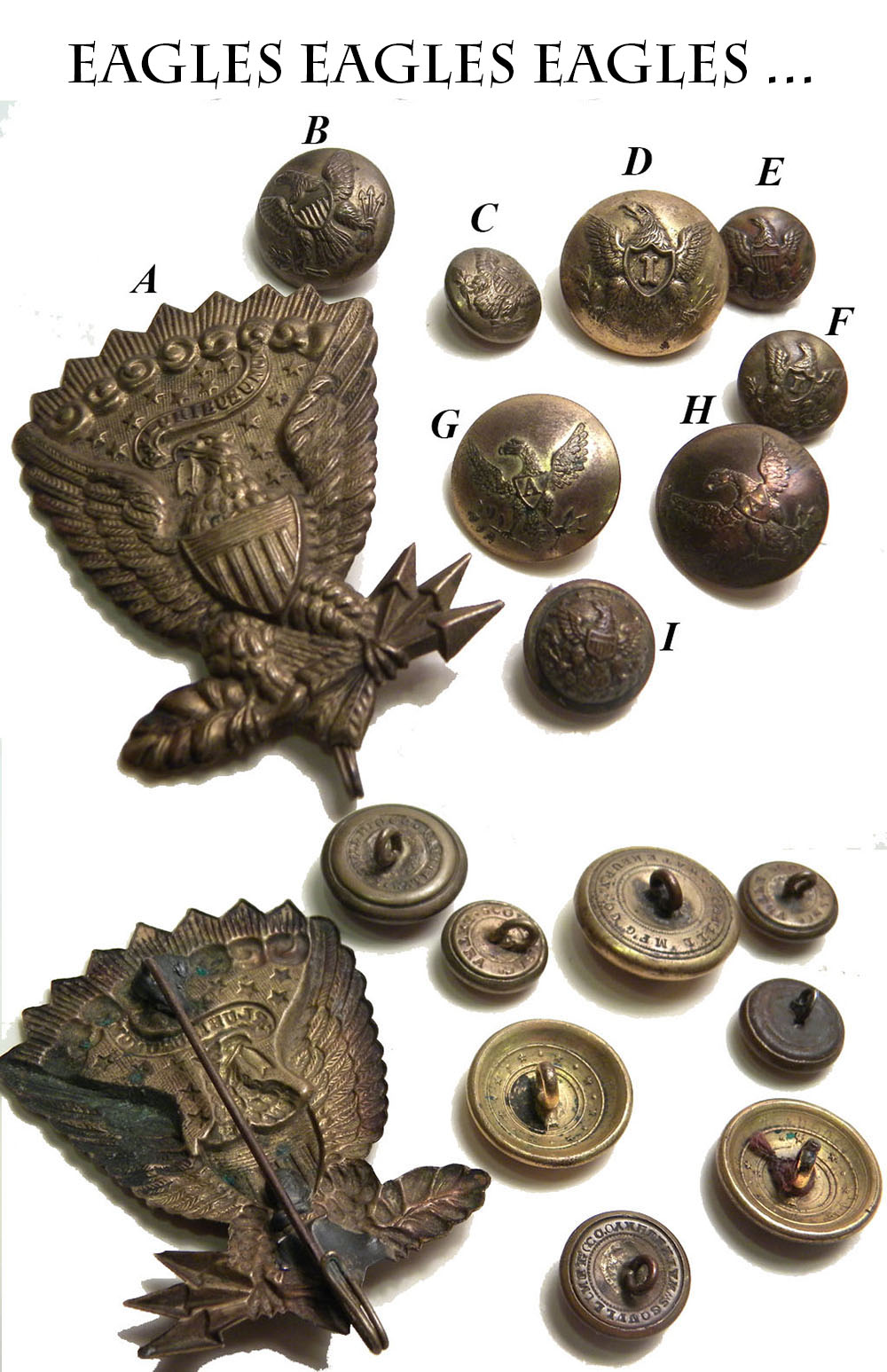
A FINE SELECTION OF ORIGINAL EAGLE INSIGNIA:
14-07-12 A) Incredibly Scarce Original M1858 enlisted Hardee Hat side eagle.
Note the double brass wire fish hook at the bottom. That is the key to identifying the REAL ones. This example modified during the period with the addition of a pin back and removal of the loops. May have been done by the soldier or may have been done for his sweetheart to wear on her breast. Rare insignia
… $200.00 SOLD
14-07-12 B) Standard large size enlisted eagle button
perfect with RMDC Scovill back mark
… $10.00
14-07-12 C) Small cuff or shell jacket size enlisted eagle button.
Scovills & Co. EXTRA back mark
… $9.00
14-07-12 D) Coat size Infantry officer’s Eagle “I” button.
Perfect with SCOVILL MF’G CO. WATERBURY back mark
… $18.00 SOLD
14-07-12 E) Another Small cuff or shell jacket size enlisted eagle button.
Scovills & Co. EXTRA back mark
… $9.00
14-07-12 F) Infantry officer’s Eagle “I” kepi or cap button.
Has the tin back for cap use as opposed to brass back for uniform. Rather scarce
… $22.00
14-07-12 G) Scarce 1830s Seminole War era up to Mexican War Artillery officer’s eagle “A” button.
Early one piece construction plus shank. Back mark is 8 raised five pointed stars. Near Mint
… $45.00
14-07-12 H) Same as G
but with some nice age patina
… $45.00
14-07-12 I) Cuff or vest size Staff Officer’s button.
SCOVILL MF’G. CO. WATERBURY back mark
… $12.00
Click Here to E-mail Us!
Call us @ 419-842-1863
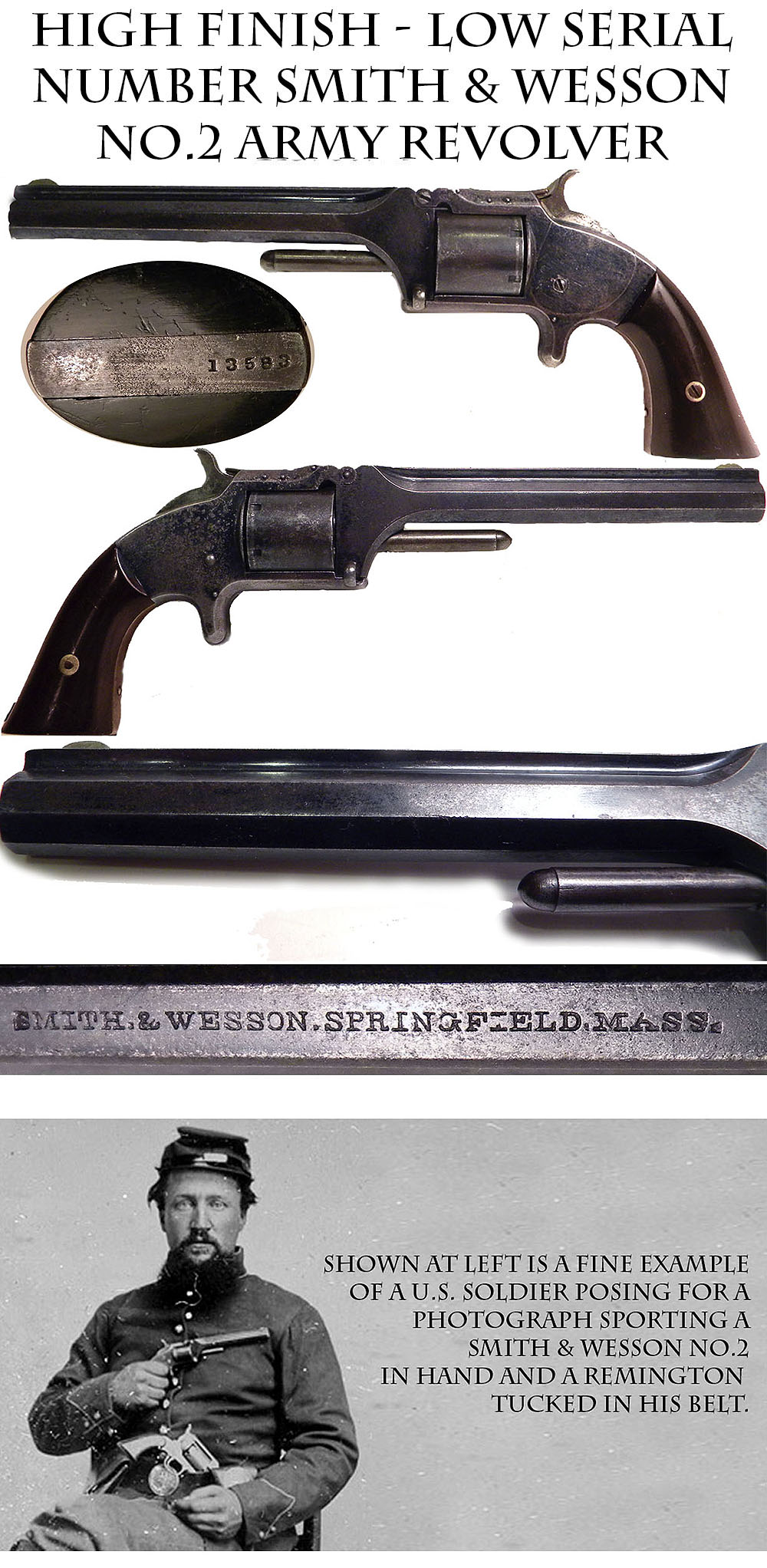
14-07-13 … A Very Fine Example of the Civil War Smith & Wesson No.2 Army Revolver:
During the Civil War Smith & Wesson was the only legal manufacturer of revolvers employing the patented bored-through cylinder chambers, a feature which allowed for the use of modern cartridge ammunition like we use today. Others attempted to knock-off the design, but S&W sued the infringers pants off and won every time. They held the exclusive rights to the Rollin White patent. The design is still used by every revolver maker to this present day. The 32 rimfire, No.2 Army is a tip-up, spur trigger, 6 shot revolver. A great many of the orders S&W received during the Civil War came from soldiers and officers. Those looking for dependable protection could do no better than the Number 2 Smith & Wesson which could be loaded quickly with waterproof metallic ammunition. The revolver was of a size suitable for the belt or holster. Our specimen here is in very fine condition retaining approx 65% original factory blue. There is some mottling on the right side of the frame. 100% original, 100% complete, and mechanically perfect. Near perfect grips, excellent bore. Very attractive. Bears early serial number 13,583. (Serials under 33,000 or so are wartime production guns). Markings are crisp. Hinge is tight and solid. This looks about the same as it did in 1863. A great example of the “most modern” of all Civil War revolvers
… $1,495.00 SOLD
Click Here to E-mail Us!
Call us @ 419-842-1863

14-07-14 … Ohio Soldier’s Bullseye Canteen …
Solid canteen nicely painted by the veteran and likely displayed in his GAR hall. “A.H. Brock Co. “H” 177th Regt.” This is Andrew H. Brock of Cleveland who served in the 177th Ohio Volunteer Infantry in 1864 and 1865. The 177th was organized in the summer of 1864 and 22 year old Andrew joined the regiment on August 22nd of that year. He served with the regiment until the war’s end and was mustered out in North Carolina June 24th 1865. The regiment upon leaving Ohio was ordered to Tullahoma and constituted a part of the garrison at that place under Gen. Milroy. It remained at Tullahoma until Hood’s invasion, when it was ordered to Murfreesboro, where it arrived on Dec. 2. On Dec. 7, Milroy’s command, including the regiment, charged the works and drove the Confederates back, capturing 2 pieces of artillery and over 200 prisoners. A few days after this, while on a foraging expedition, the regiment had an engagement with the enemy, in which it lost several wounded. Jan., 1865 it proceeded down the Tennessee and up the Ohio to Cincinnati, where it took the railroad for Washington, D. C. From there it moved to Annapolis, Md., and embarked on a vessel for North Carolina, arriving at Fort Fisher on Feb. 7. It was engaged in two attacks on the enemy’s works from the Cape Fear river to the coast, and crossed the river and participated in the flank movement which compelled the Confederates to evacuate Fort Anderson. It next engaged the enemy at Town creek, charging in the rear and capturing the entire command. The next morning it arrived opposite Wilmington, where it remained about a week, then joined Gen. Cox at Kinston and proceeded to Goldsboro, where it joined Sherman’s army. After the surrender of Gen. Johnston the regiment was sent to Greensboro, N. C., where it was mustered out on June 24, 1865, in accordance with orders from the war department. A fine historical Bullseye Canteen
… $335.00 SOLD
Click Here to E-mail Us!
Call us @ 419-842-1863

14-07-15 … Perhaps the Rarest Dealer Marking Known on a Colt Revolver:
We are all familiar with gun dealer and outfitter Benjamin Kittredge of Cincinnati whose name is found stamped on innumerable arms and related accoutrements of the 1860s. His store in Cincinnati is legendary. But this wonderful four inch barrel Colt Pocket revolver is beautifully stamped “CHAS. KITTREDGE 50 4th St. ST. LOUIS, MO.” This is the first such marking I have encountered in nearly 45 years of collecting and trading guns. The revolver is a very solid Model 1849 Colt Pocket revolver with four inch barrel. It has a two line bracketed New York barrel legend, and five shot cylinder. Condition is NRA “very good ++”. Retains most of the stagecoach holdup cylinder scene. All serial numbers are matching 168,831 including the wedge. It is 100% original. 100% complete, and mechanically perfect. This Colt surfaced at a Cincinnati auction earlier this year. I was fascinated by the marking and bought it. I showed the marking to several very ADVANCED Colt collectors including Bill Myers here in Toledo, and Compton LeBeau of New Orleans … neither had seen the marking previously. I then set about researching period newspapers which was difficult as St. Louis papers from the period are not readily accessible. What I found was quite telling. During the first week of January 1860 … in three issues of the Cincinnati Daily Press Ben Kittredge advertised a sale on Colt firearms … and in those three ads ONLY — he lists Chas. Kittredge of 50 4th Street in St. Louis as one of his dealer agents. I will assume that Charles was a brother or cousin. But aside from the three ads in January I can find no other mention of Charles Kittredge in any of Ben’s ads. Perhaps he died? … cast his lot with the South? … left for places unknown??? I will leave the additional research for you to complete. This Colt is truly a wonderful piece of frontier Americana. St. Louis was the jumping off point for all western adventurers and most of the wagon trains going west. This wonderful 1860 era Colt with unquestionable western connection is one of the most interesting arms I have been fortunate enough to find. Unique in my experience
… $2,850.00
Click Here to E-mail Us!
Call us @ 419-842-1863
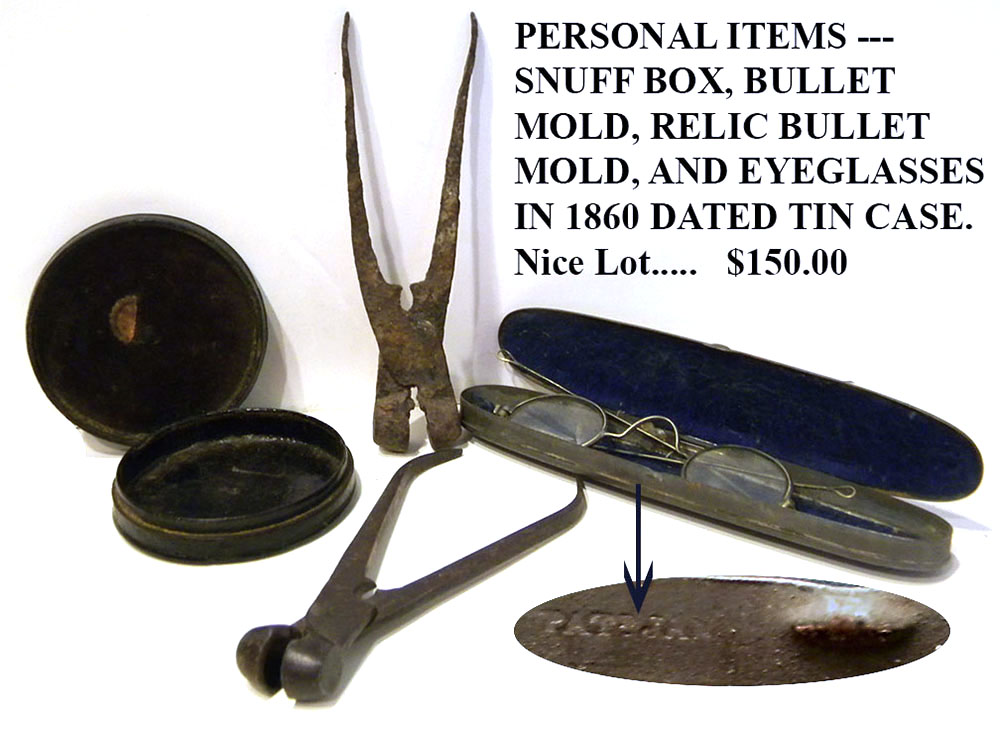
14-07-16 … Nice Lot of Early Personal Items:
First is a composition circular snuff box circa 1840s. Second a nice Kentucky rifle scissors style bullet mold roughly .40 caliber. Third another similar mold, A relic dug up at a frontier home site by a 20th century relic hunter. Fourth a nice pair of Ben Franklin spectacles in the original blue lined tin carrying case which bears the Parker Patent marking of Pat. Jan 24, 1860. Only the PAT. JAN. is legible due to a poor strike when it was made. But it is clearly the Parker marking. A fine discount lot of interesting early items
… $150.00
Click Here to E-mail Us!
Call us @ 419-842-1863

14-07-17 …Confederate Style 2-Band Scoped Sergeant’s Rifle:
It took me a while to figure this one out when it was brought into the shop by a local antique seller. What we have here is a 2-band Enfield that was used and improved by an old skirmisher from the NSSA (North-South Skirmish Association … now in its 64th year which is hard to believe). At any rate. This is an original 2-Band Enfield with the following modifications… the barrel is a Bill Large custom shooters barrel with incredible bore and fast twist rifling Bill has been gone a lot of years now, but his barrels are still used by hundreds of shooters. Second the shooter added a telescopic tube sight like we see on the Whitworth rifles. This sight appears European to me … possibly WW1 era???? This sight may be a rarity in its own right. Finally the shooter marked the original gun stock with a large JS Anchor stamp on the underside so that it would be “authentic” in his Confederate soldier impression on the skirmish line. These “improvements” are standard fare for skirmish shooters, and reenactors. It is too bad the skirmisher’s family did not keep the original barrel with the gun but such is the fate of many antiques. It is great the way it is and quite interesting
… $850.00 SOLD
Click Here to E-mail Us!
Call us @ 419-842-1863
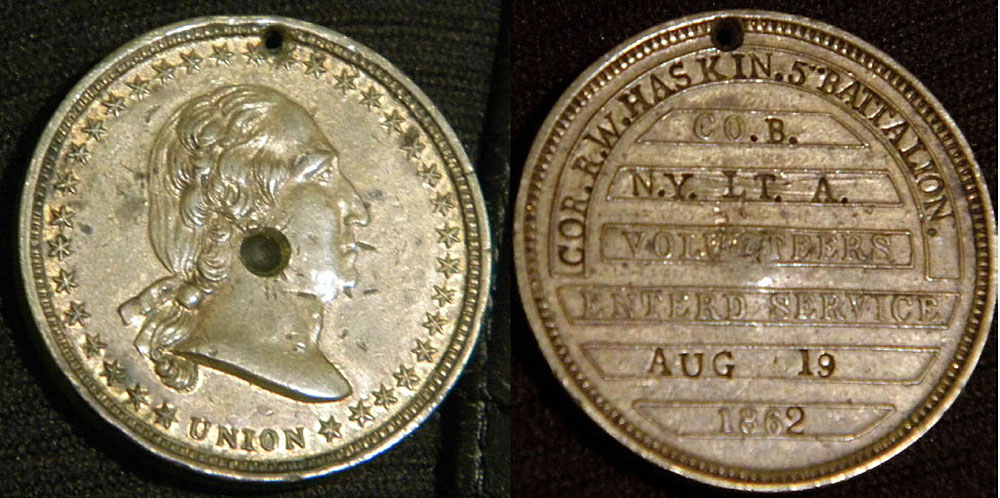
14-07-18 … Rare Form Civil War Dog Tag New York Artilleryman:
A very handsome George Washington motif brass dog tag likely made by the Scovill Mfg Co. This disc is quite a scarce variant with the reverse being pre-marked with some of the military nomenclature. Reverse stamped “Cor. R.W. Haskins 5th Battalion Co. “B” N.Y. Lt. A. Volunteers Enlisted Aug. 19th 1862”. A quick check of the records finds our man. Corporal Robert W Haskins 5th Battalion NY Light Artillery and then Co. “G” 10th New York Heavy Artillery. He served from 8/13/1862 through 4/29/1864. He must have done something naughty because they busted him down to private in March of 1863. The 10th Artillery was formed by consolidating the 4th, 5th, and 7th Battalions of Artillery late in 1862. The unit served as infantry and saw combat and casualties at Cold Harbor and Petersburg. A very nice CW dog tag. Center of obverse shows that someone at one time thought about drilling a hole in the center of the disc, but then changed his mind. Otherwise about perfect. A very handsome and scarce Civil War dog tag …
100916
… $795.00 SOLD
Click Here to E-mail Us!
Call us @ 419-842-1863
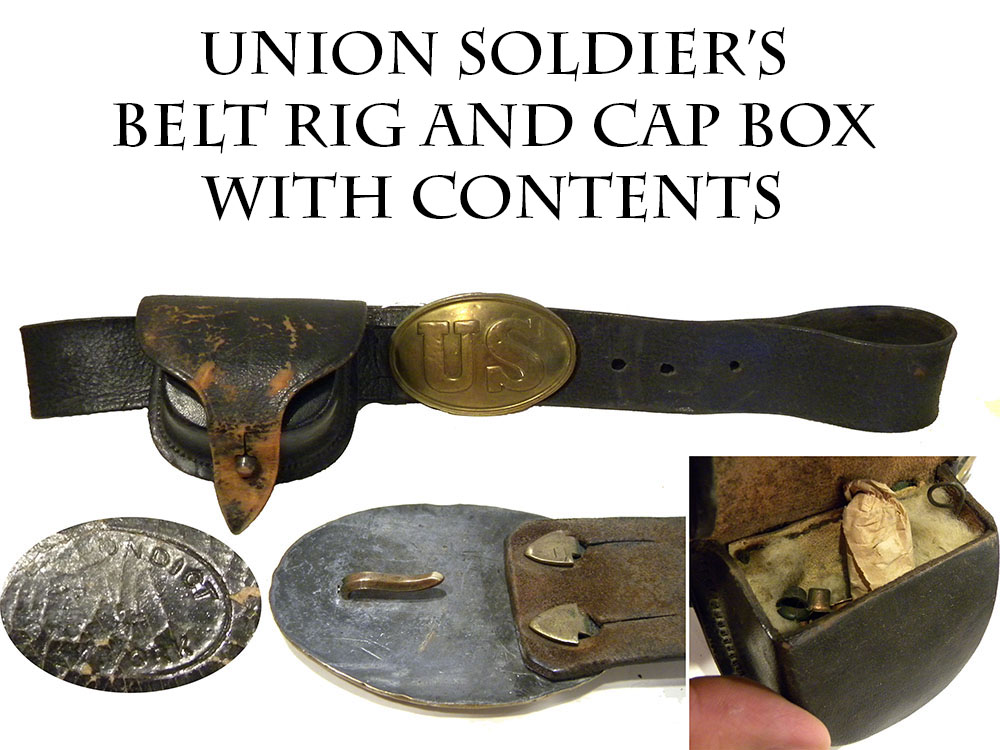
14-07-19 … Nice Solid Yankee Soldier’s Belt Rig:
Overall fine+ condition. Harness leather waist belt sports a very handsome US oval waist belt plate with arrow hooks on the back. The soldier removed the keeper from the free end of the belt as we see with nearly all actually worn belts. Cap box has Condict NY maker’s stamp on the inner flap. Interior has most of the original lambswool, the original nipple pick, several original caps, and the original government issue paper wrapper the caps came in. The wrapper held 12 caps when issued. Top notch condition and neat with the contents of the cap box still present.
… $535.00 SOLD
Click Here to E-mail Us!
Call us @ 419-842-1863

14-07-20 … Lieutenant Forshay’s Buttons Worn During Picket’s Charge
… 126th New York Volunteers. These infantry officer’s buttons were worn on the uniform of Lieut. Charles H. Forshay of the 126th New York Volunteers at The Battle of Gettysburg during Pickett’s Charge.
Three or four years ago Forshay’s silver identification badge and his infantry officer’s buttons off his uniform came onto the market. The lot changed hands twice and then I bought it. There are five small Eagle “I” buttons of the six that adorned his cuffs and twelve matching large frock coat Eagle “I” buttons bearing “Extra Quality” back marks. The five small buttons bear “Waterbury Button Co.” back marks. There were also three larger eagle “I” buttons present presumably from his 4-button fatigue blouse worn as an NCO later that are not offered here. The badge and buttons were purchased by me on Thursday September 22nd 2011. I sold his ID shield in the Spring of 2014 and am now selling the Gettysburg buttons. Each button is being offered separately. At the Battle of Gettysburg Lieutenant Forshay was in the thick of things at Pickett’s Charge. Some reports show him being wounded in the leg with witnesses saying he was clearly limping on the field. Other reports say he turned and ran from the line when the firing got to its hottest. Forshay disputed this report. What no one disputes is that he was clearly present on the field during Pickett’s Charge.
What is known for sure is that Forshay received his commission just prior to Gettysburg and was reduced to Sergeant after the Battle. This promotion sequence is perfect evidence that these officer’s buttons are the ones on his uniform in early July 1863 while he was present at Pickett’s Charge. Whether Forshay was a wounded hero wrongly accused of running, or whether he could not stand the firing from Pickett’s men is not known. The issue was argued at his court martial. In any event he was unquestionably on the field and these buttons were present on his uniform at the time the most famous charge of the Civil War was made. That makes each button one darn rare Civil War relic. There aren’t many items you can point to as truly “Being At Pickett’s Charge”. When these are gone “they’re gone”. Each button comes with my signed letter of authenticity attesting to the history
Coat Buttons …. … $100 each SOLD
Cuff buttons … … $95.00 each SOLD
One of each …. …. $175.00 pr. SOLD
Click Here to E-mail Us!
Call us @ 419-842-1863
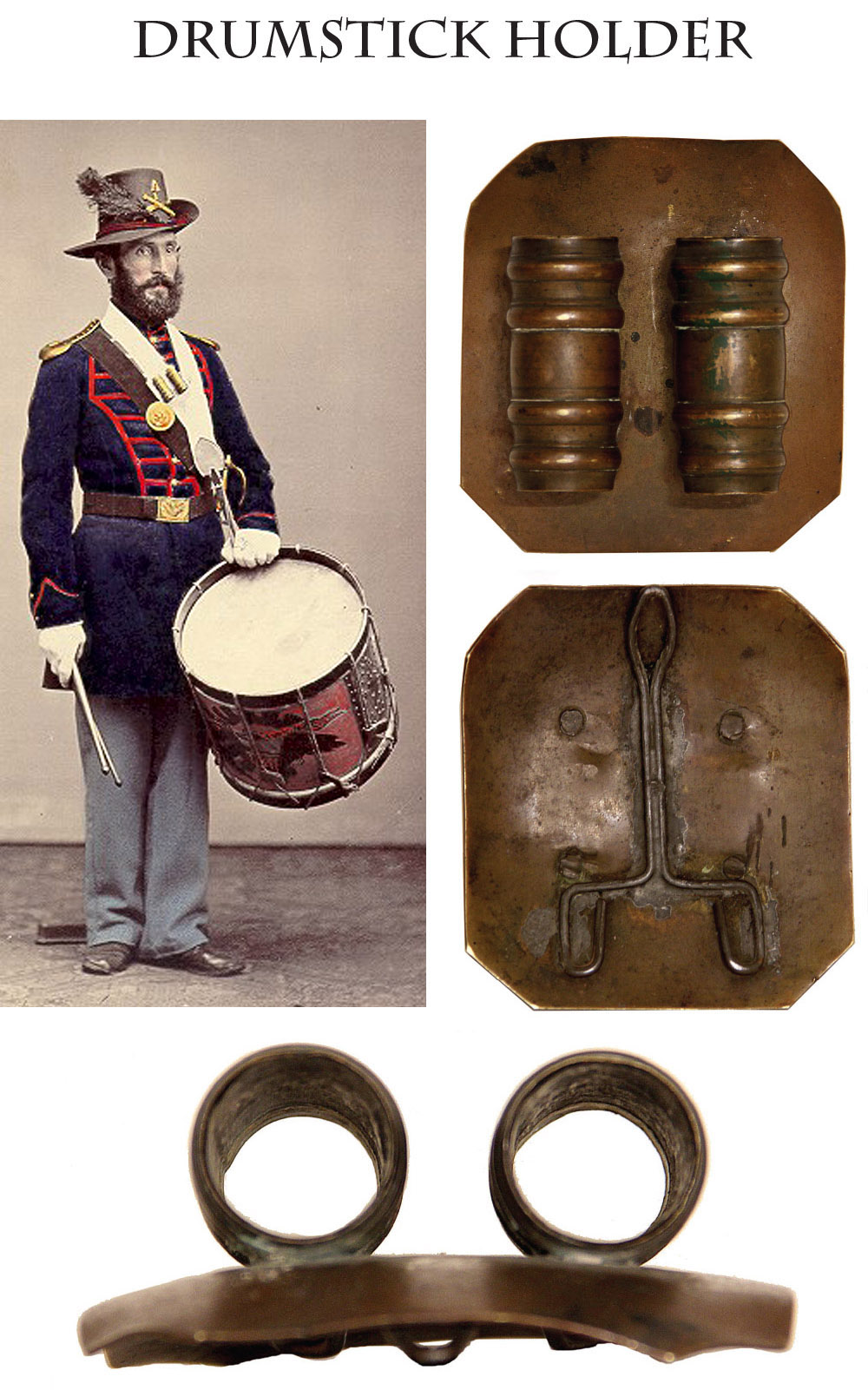
14-07-21
…
Government Issued Drumstick Carriage:
These clipped corner rectangular brass plates with two barrel shaped tubes were worn on the drummer’s drum sling which went across his chest. See the photo showing its use. I am aware of one Civil War photograph where the drummer has one of these fastened to his waist belt. They were affixed to the sling by iron wire bent to form hooks and soldered to the reverse. The issue drumsticks were strongly tapered and slid into the tubes with the tops projected above the upper rims of the tubes. This one has a nice undisturbed age patina on the brass and the wire hooks on the reverse have been bent flat. You can bend them back if you wish but I am leaving them this way. Drummers were company musicians and remained in service as “field music” even after regimental bands were mustered out. These are a darn scarce piece of Union Army Issue equipment
… $495.00 SOLD
Click Here to E-mail Us!
Call us @ 419-842-1863
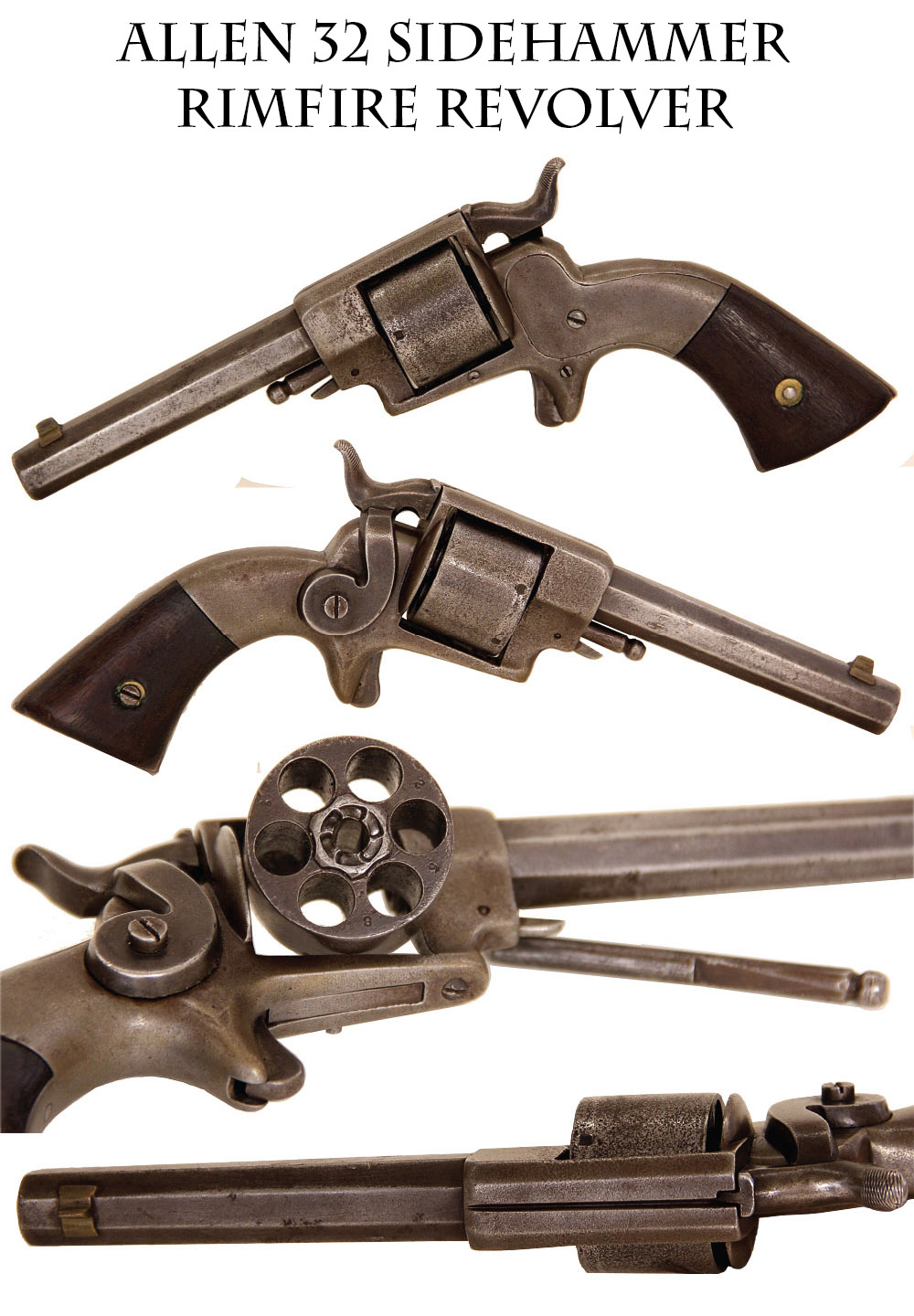
14-07-22
… Allen & Wheelock.32 Caliber Sidehammer Rimfire Revolver:
Six shot, 3.75″ barrel, totally unmarked: Made between 1859 and 1862. These fit in with my interest in the smaller pocket pistols that were far more widely carried during the period than the large frame revolvers. This pistol has nice wood and smooth grey metal. Light salt and peppering overall on the cylinder and cylinder arbor. Front entry cylinder pin, grooved top strap, projecting button. I see no cylinder scene or markings at all except a cylinder number, but these guns were usually batch numbered rather than serial numbered. Gun cocks and indexes fine. When cocked the cylinder stop functions “sort-of”, but the cylinder will move a little bit on full cock. A nice little Civil War period pocket revolver. Flayderman # 5a 072
… $425.00
Click Here to E-mail Us!
Call us @ 419-842-1863

14-07-23 … Classic / Standard Eagle War of 1861 Dog Tag 4th Vermont Volunteer Infantry / WOUNDED AT THE WILDERNESS:
Made by the Scovill Manufacturing Co. This eagle pattern identification disc is the most frequently encountered and most attractive of all the CW “dog tags”. This one worn by Albert Kinsman of Rochester VT; He enlisted on 8/26/1861 as a Private. He was Mustered Out on 9/30/1864. He was Wounded May 5th 1864 at The Battle of The Wilderness. He was promoted to corporal and sergeant during his service. The regiment was mustered in at Brattleboro, September 20, 1861, started for Washington next day, and in five days joined the other Vermont troops then in Virginia, and was soon followed by the Fifth and Sixth, which, with the Second and Third who had “gone before,” made up the “Old Vermont Brigade,” In the battle of the Wilderness, Va., in May, 1864, the regiment suffered incredible losses. Seven officers were killed and eleven wounded, one of whom died of his wounds, and out of less than five hundred fifty enlisted men in that battle, forty-one were killed outright. Two hundred twenty-three were wounded, forty-three mortally, and four were missing; so that, in this battle, the actual death loss was eighty-four, the largest suffered by any Vermont regiment in one battle, and a loss seldom equalled by any infantry regiment in a single engagement during the war. Its total losses by death were in excess of those of any other infantry regiment from the State. A most historic CW relic, present on the person of Albert Kinsman who was a casualty in one of the bloodiest battles in history
… $950.00 SOLD
Click Here to E-mail Us!
Call us @ 419-842-1863
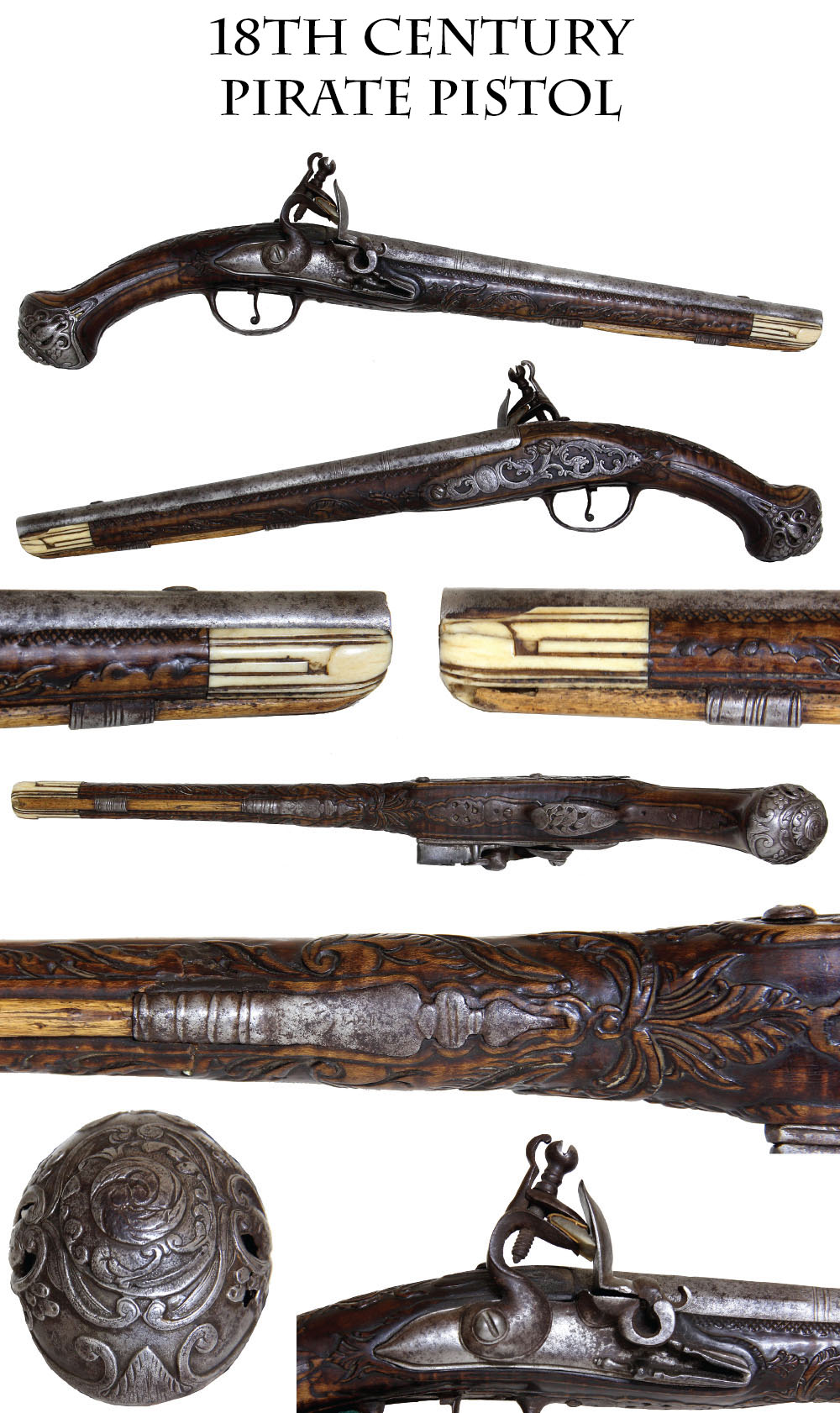
14-07-24 … High Quality 18th Century Barbary Coast Pirate Pistol:
Large – roughly 19 inches overall – full stock flintlock pistol. Circa 1750 or earlier. Has beautifully relief carved stock. Nose cap is a wonderful piece of elephant ivory carved with horizontal flutes. Rod has been replaced. The trigger guard and butt cap are deeply chiseled and engraved in the deepest and highest quality. The twelve inch barrel shows worn hand engraved decorations near the breech that were certainly gold inlaid when the gun was new. Truly high art. The lines and form of this marvelous ancient pistol show that it likely hails from the eastern Mediterranean area. Perfect for display with ancient maritime weapons from the days of pirates. The “pirates” who infested the southern Mediterranean – the Barbary Coast – between the 16th and 18th centuries were actually traders engaged in a massive extortion racket. They waged full-scale wars and destabilized nations. Most of the seaborne warfare centered on three Barbary states, Tripoli, Tunis and Algiers, which owed their allegiance to the Ottoman Empire. From the late 16th century the galleys of the Moors had been preying on Christian shipping in the Mediterranean, enslaving Christian mariners and offering sanctuary to outlaws. For much of the 18th century, peace on the Mediterranean was maintained by bribing the Barbary pirates with annual licenses. This was how matters remained until after the Revolutionary War when Britain and the United States banded together to curtail piracy. Algiers was destroyed by a British fleet in 1816 and annexed by France. If you have a taste for Barbary Coast Pirate lore here is your gun. A truly high quality antique firearm in fine condition, exhibiting top end craftsmanship
… $1,650.00 SOLD
Click Here to E-mail Us!
Call us @ 419-842-1863

14-07-25 … Model 1910 – World War One US Navy Enlisted Medical Supply Belt:
About perfect condition with early 1912 style rimmed snaps. Nicely marked on the canvas with Mills stamping. Also marked on the stamped metal reenforcing belt tip with Mills marking and 1917 date. Thek WW1 experts tell me these are easily worth $150. So I’m pricing it friendly at
… $125.00 SOLD
Click Here to E-mail Us!
Call us @ 419-842-1863
Layaways are Welcome
Need to split your order into multiple payments? No problem! A simple 20% earnest money deposit will hold your item for you.-acf
You can then pay it off in easy installments that fit your budget.
Read Terms Here
Items to Sell? Contact Us
I am always interested in buying ANYTHING from the American Civil War… Guns, Swords, Civil War Muskets, Knives, Uniforms, Flags, Medals, Badges, Diaries, Letters, Autographs, Buttons, photographs, tintypes, daguerreotypes, Insignia, Camp Items, Battlefield Relics, canteens, Drums, Etc… Call 419-842-1863 and ask for Dave Taylor.

